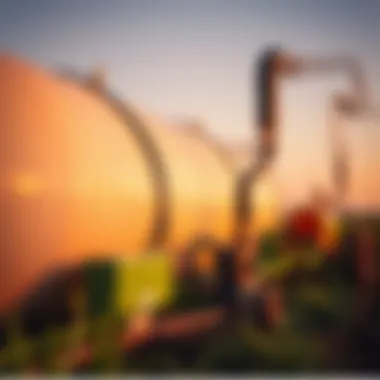Anhydrous Ammonia in Agriculture: Essential Insights


Intro
In the world of agriculture, the quest for productivity and efficiency goes hand-in-hand with environmental stewardship. One of the critical players in this arena is anhydrous ammonia, a nitrogen-rich compound that has been long favored for its remarkable capacity as a fertilizer. This guide serves to unpack the multifaceted nature of anhydrous ammonia—its applications, advantages, and the associated safety measures that every farmer must be aware of. The relevance of this exploration is underscored by the ongoing conversation about sustainable farming practices that balance high agricultural output with ecological responsibility.
Key Insights
Overview of the Topic
Anhydrous ammonia is a form of nitrogen that is often used in agricultural settings due to its effectiveness in promoting plant growth. Unlike other fertilizer types, it has no water content, providing a concentrated source of nitrogen that plants readily absorb. This unique property enables farmers to apply it directly into the soil, offering a means to enhance crop yields significantly.
Importance in Agriculture/Horticulture/Agronomy
The role of anhydrous ammonia in agriculture cannot be overstated. Farmers frequently cite several reasons why this compound is an invaluable resource:
- Cost-effective: Anhydrous ammonia is generally cheaper than urea or other nitrogen fertilizers on a per pound of nitrogen basis.
- High Nutrient Content: With a nitrogen content of about 82%, it is among the most concentrated nitrogen fertilizers available.
- Versatility: Applicable to various crops, it adapts well to different farming systems, whether conventional or no-till practices.
Surveying the agricultural landscape, its applications extend beyond mere fertilization. It plays a pivotal role in soil health by enhancing microbial activity, which is essential for nutrient cycling.
"Proper application of anhydrous ammonia can be the difference between a mediocre harvest and a bumper crop."
In essence, when used correctly, it not only supports productivity but also aligns with evolving agricultural standards focused on sustainability and ecological balance.
Sustainable Practices
Eco-Friendly Techniques
Sustainable approaches to using anhydrous ammonia are critical in today’s farming considerations. Some techniques include:
- Timing of Application: Applying anhydrous ammonia when conditions are optimal reduces nitrogen loss to the atmosphere and maximizes plant uptake.
- Incorporation into Soil: Moving the ammonium into the soil shortly after application minimizes volatilization losses. This could mean using a knife injector that places the nitrogen at root level.
- Cover Cropping: Utilizing cover crops can help maintain soil structure and health, promoting better nitrogen retention and reducing the risks of leaching.
Case Studies on Sustainability
Real-world exemplars demonstrate the positive impacts of responsible anhydrous ammonia use:
A study conducted by the University of Nebraska highlighted a farm that implemented a combination of timing and application technology. This farm reported a 20% increase in corn yields while noticeably reducing their nitrogen footprint by 15%. By investing in advanced soil health practices alongside traditional methods of ammonia application, the farming landscape shifted toward a more environmentally-sensitive operation.
Tools & Resources
Essential Equipment and Technologies
Farmers looking to enhance their practices should be equipped with essential tools:
- Knife Applicators: This equipment injects anhydrous ammonia directly into the soil without surface disturbance.
- Flow Meters: To monitor the precise application rate of ammonia, ensuring efficiency and cost savings.
- Soil Testing Kits: Understanding soil composition can inform the best ammonia application strategies and timing.
Recommended Books and Readings
For those interested in delving deeper into the subject, consider the following resources:
- "Fertilizers and Soil Amendments" by David D. Ritchie, which covers general fertilization practices including ammonia use.
- Research articles from the American Society of Agronomy, available online at www.agronomy.org, which delve into innovative practices and technologies in soil management.
The effectiveness of anhydrous ammonia in agriculture is evident when combined with a sound understanding of sustainable practices and the right equipment. Thus, farmers and enthusiasts alike can harness its potential while minimizing any negative impact on the environment.
Understanding Anhydrous Ammonia
Anhydrous ammonia plays a crucial role in agriculture, serving as a primary nitrogen source that can revolutionize farming practices. Understanding this compound is key for farmers and agricultural enthusiasts aiming to optimize crop yields while maintaining soil health. Comprehending anhydrous ammonia entails delving into its chemical properties, the production process, and its market relevance. Each aspect reveals how this substance can significantly impact agricultural success.
Chemical Properties
Anhydrous ammonia, with the chemical formula NH₃, is a colorless gas that possesses a sharp, pungent odor. When discussing its properties, it's essential to note that it has a high nitrogen content, approximately 82% by weight. This high concentration makes it particularly valuable as a fertilizer, as plants thrive on nitrogen, which is essential for their growth.
When introduced into the soil, anhydrous ammonia behaves like a liquid under high pressure. Once injected, it transforms into a gas, allowing it to penetrate the soil quickly and providing the roots with readily available nutrients. However, its volatility means that proper handling and application techniques are vital to minimize losses through evaporation and ensure effective use.
Production Process
The production of anhydrous ammonia is primarily carried out through the Haber-Bosch process. This method combines nitrogen from the air and hydrogen from natural gas or other sources under high heat and pressure to create ammonia.
To put it simply, here’s a closer look at the process:
- Air Separation: Nitrogen is separated from oxygen in the air.
- Hydrogen Production: Hydrogen is derived, typically from methane gas.
- Ammonia Synthesis: Nitrogen and hydrogen are combined under specific conditions in a reactor to produce anhydrous ammonia.
This process is energy-intensive but essential for producing ammonia on a scale that meets agricultural demand. Countries with abundant natural gas resources often lead in this production, making the availability and price of anhydrous ammonia closely tied to global energy markets.


Market Relevance
In today's agricultural landscape, understanding the market relevance of anhydrous ammonia is not just beneficial but crucial. The demand for fertilizers continues to rise due to an increasing global population and the need for enhanced food production. As anhydrous ammonia offers a cost-effective solution with high nitrogen content, its use has become widespread among farmers.
The market dynamics are influenced by numerous factors:
- Global Demand: With food security becoming a growing concern, the demand for high-yielding agricultural techniques has shot up.
- Regulatory Environment: Policies focusing on sustainable farming practices may impact how anhydrous ammonia is utilized or regulated.
- Price Fluctuation: The connection to natural gas prices can lead to volatile pricing for farmers.
As the agricultural sector evolves, an understanding of these market dynamics will enable farmers to make informed decisions about utilizing anhydrous ammonia in their operations. The implications of this compound extend beyond mere crop management; they touch upon economic considerations that define the agricultural industry.
Role of Anhydrous Ammonia in Agriculture
Anhydrous ammonia plays a pivotal role in modern agriculture, especially as a chief nitrogen source for crops. This significance is grounded in its ability to provide crops with the vital nutrients needed for growth, enhance yields, and improve overall soil health. As the cornerstone of fertilizer applications, understanding how anhydrous ammonia interacts with agricultural practices is essential for farmers and agricultural enthusiasts alike. Particularly in an era where sustainable farming is emphasized, comprehending this role can influence how farms are managed, leading to more fruitful harvests.
Nitrogen Supply for Crops
Nitrogen is an essential macronutrient necessary for the growth and development of plants. Anhydrous ammonia contributes to this nutrient supply as one of the most concentrated forms of nitrogen available. Upon application, anhydrous ammonia is incorporated into the soil, resulting in a quick nitrogen release that plants can readily absorb. This quick assimilation is beneficial at critical growth stages such as seeding and tillering, where plants require an immediate nitrogen boost.
Moreover, the method of application can influence the effectiveness of nitrogen supply. Farmers using injection methods can position anhydrous ammonia deeper in the soil profile, where roots of crops can easily access it. Unlike other forms of nitrogen fertilizer, anhydrous ammonia transforms from a gas to a liquid state, which keeps it stable and effective. If done properly, it can promote robust growth in corn, wheat, and various other crops, ensuring they receive adequate nutrients right when they need them.
Enhancements in Crop Yield
When it comes to enhancing crop yield, anhydrous ammonia's efficiency showcases why many farmers opt for its use. Compared to traditional fertilizers, which may contain higher moisture levels and need more frequent application, anhydrous ammonia stands out for its concentrated nitrogen content and low volume requirements. This means that farmers can achieve greater yields without overloading the soil with excess nutrients.
Research suggests that, when applied correctly, anhydrous ammonia can increase crop yields by as much as 30% under optimal conditions. This substantial enhancement is often due to the improved nutrient uptake facilitated by the immediate availability of nitrogen. Furthermore, the economic benefit becomes evident as higher yields correlate with better profitability for farmers.
It’s crucial to note that timing and conditions during application can significantly affect these yields. A well-timed application—synchronized with the crop's growth stage—can yield impressive results.
Soil Health Improvement
In addition to boosting yields, anhydrous ammonia offers benefits for soil health itself. When incorporated into the soil, it encourages microbial activity, leading to healthier soil ecosystems. This process not only fosters nutrient cycling but also promotes better soil structure and aeration—a factor that is vital for root development.
Moreover, using anhydrous ammonia can help minimize the risk of nutrient leaching more than other types of fertilizers may. This stability protects the soil from nutrient loss due to rainfall or irrigation. In the long run, it supports sustainable practices, keeping the land fertile and productive for years to come.
In summary, the role of anhydrous ammonia in agriculture cannot be overstated. Its ability to supply nitrogen, enhance yields, and improve soil health makes it a fundamental component of modern farming strategies. As agriculture continues to evolve, leveraging this knowledge will help growers make informed decisions that not only advance productivity but also align with sustainability goals.
Application Techniques
The use of anhydrous ammonia in farming goes far beyond just having a nitrogen source. Its application techniques are crucial, providing not only the means to deliver this fertilizer into the soil but also determining how effective and efficient its usage will be. Correct application can lead to improved crop health, reduced costs, and minimized environmental risks. Understanding these techniques allows farmers to harness the full potential of anhydrous ammonia while maintaining safe practices.
Injection Methods
Injection methods are one of the primary ways to apply anhydrous ammonia. By injecting it directly into the soil, this technique minimizes nitrogen loss and maximizes availability to plants. The depth and angle of injection can be tailored based on soil type, crop needs, and existing moisture conditions.
- Advantages of Injection Methods:
- Reduces evaporation losses
- Enhances nutrient uptake by plants
- Decreases risk of surface runoff
Using specialized equipment like soil injection knives or injectors, farmers can ensure precise placement. A common practice is to inject at a depth of 6 to 8 inches, as this allows for adequate nitrogen absorption while reducing exposure to air. Additionally, it’s advantageous to inject anhydrous ammonia during cooler parts of the day to limit volatilization and loss to the atmosphere.
Surface Applications
Surface application is another technique employed, though it often falls short when compared to injection methods. This involves spreading the anhydrous ammonia over the soil surface. While it’s generally easier and less labor-intensive, it carries its drawbacks.
- Disadvantages of Surface Applications:
- Higher nitrogen loss due to volatilization
- Increased potential for nitrogen runoff into waterways
- May create uneven nutrient distribution
Farmers may combine surface applications with aeration or tillage to better incorporate the ammonia into the soil. However, this method typically requires more precise timing with irrigation or rainfall to ensure the ammonia gets absorbed into the soil and doesn’t simply evaporate away.
Timing Considerations
Timing in the application of anhydrous ammonia can significantly impact its efficacy. Applying at the wrong time, like during a dry spell, may lead to nitrogen being less available for crops when they need it most. Conversely, timing it when plants are in their peak uptake stage can boost overall crop yield.
- Key Timing Factors:
- Seasonal considerations: Late fall or early spring are often preferred,
- Moisture levels: Following rain events can enhance absorption,
- Crop needs: Synchronizing with crop growth stages ensures maximum benefit.
It's crucial to monitor weather forecasts and understand soil conditions. Farmers should keep track of local climate patterns to determine the best windows for application. This can be a science and an art, as getting it just right can turn the tables in terms of yield and agricultural output.
"Timing is everything in agriculture; it can mean the difference between failure and success."


Ultimately, selecting a suitable application technique depends on various factors: farm size, crop type, and economic feasibility among others. Each technique has its merits, and understanding when and how to apply anhydrous ammonia properly can set the stage for a fruitful harvest.
Benefits of Anhydrous Ammonia
The role of anhydrous ammonia in agriculture stretches beyond merely being another fertilizer. It's a versatile, efficient source of nitrogen that boasts multiple key benefits. Understanding these advantages can help farmers and agricultural practitioners make informed decisions about its application in their farming practices.
Cost-Effectiveness
One of the most striking benefits of anhydrous ammonia is its cost-effectiveness compared to other nitrogen sources. Though the initial investment for application equipment might seem steep, farmers can experience substantial savings in the long run. Anhydrous ammonia is generally cheaper per unit of nitrogen than solutions like urea or ammonium nitrate. For instance, when calculated over large-scale applications, the price per pound of nitrogen can reflect significant savings.
Moreover, anhydrous ammonia’s high nitrogen concentration—typically around 82%—means that less product is required to achieve the same nitrogen levels found in other fertilizers. Farmers can pour more nutrients into the ground without breaking the bank, and with the potential for cost-savvy budgeting, there's room for investments in other essential areas of production.
Storage Advantages
The storage characteristics of anhydrous ammonia present another attractive feature for agricultural use. This compound is stored in a liquefied state which allows for a higher density of nitrogen per storage unit. This means a smaller storage footprint is needed. Farmers can stockpile more nutrients in less space, which is especially advantageous for operations with limited storage capabilities or those located in remote areas where logistics can be a headache.
Additionally, anhydrous ammonia can safely be stored under pressurized conditions. Its unique chemical properties provide a long shelf life without the risk of significant degradation over time, unlike some nitrates or biological fertilizers that can lose efficacy if not used promptly. As a result, producers have greater flexibility in sourcing their fertilizer when markets fluctuate.
Flexibility in Application
Flexibility is the name of the game when it comes to anhydrous ammonia application. It can be utilized in diverse farming practices and integrated seamlessly into various cropping systems. Whether it's no-till or conventional farming, farmers can adapt the usage of anhydrous ammonia to fit their specific soil and climate conditions.
- Injection Techniques: This method allows the ammonia to be applied directly into the soil, minimizing loss to the atmosphere and maximizing nitrogen uptake by the crops.
- Surface Applications: Though less common, surface application is sometimes used in particular scenarios where soils are more amenable to this approach.
- Timing Adjustments: Anhydrous ammonia can be applied in different seasons based on crop cycles and nitrogen need, thus offering a tailored approach to nutrient management.
"With such adaptability, farmers can fine-tune their use of anhydrous ammonia to achieve better crop yields and soil health, aligning with both economic and sustainability goals."
The flexibility inherent in the application of anhydrous ammonia makes it a valuable asset for farmers looking to optimize their nitrogen input while striving to meet agricultural production demands and sustainability initiatives.
Challenges Associated with Anhydrous Ammonia
The utilization of anhydrous ammonia in agricultural practices comes with its own set of challenges that farmers and those involved in the agricultural sector must contend with. While this nitrogenous fertilizer offers several benefits, understanding the obstacles is essential for making informed decisions. Addressing these issues is not merely about compliance; it’s about ensuring sustainability in agricultural practices.
Environmental Concerns
Anhydrous ammonia, when improperly handled, can pose significant threats to the environment. This fertilizer is highly volatile, which means it can easily be lost to the atmosphere through a process known as volatilization. When nitrogen escapes into the air, it not only reduces the effectiveness of the application but also contributes to air pollution.
Moreover, if there is excessive runoff after heavy rains, it can seep into nearby water bodies. This can lead to algal blooms, which choke out aquatic life by depleting oxygen levels in the water. As a result, it's critical to integrate best practices for application, including monitoring weather conditions and employing precise application techniques to minimize these risks. It’s a balancing act that every farmer must navigate to protect both their crops and the ecosystem at large.
Health and Safety Risks
The health and safety implications of using anhydrous ammonia cannot be overstated. As an extremely corrosive substance, it can cause severe chemical burns upon contact with skin or eyes. Even inhalation of its fumes can lead to respiratory issues or other adverse health effects. These hazards necessitate stringent safety protocols when handling the product.
Farmers must be well-equipped with Personal Protective Equipment (PPE) like gloves, goggles, and masks. Furthermore, appropriate training on the safe operation of equipment should not be viewed as optional; it is a critical component for anyone involved in the handling process. Maintaining safety is not just about compliance with regulations—it's about creating a safe working environment for everyone involved, from farm workers to the surrounding community.
Regulatory Compliance
Compliance with regulations surrounding the use of anhydrous ammonia adds another layer of complexity. Various local, state, and federal laws govern its storage, application, and transportation. Failure to adhere to these regulations can result in hefty fines and legal repercussions, which can impact a farm's bottom line significantly.
Those in the agricultural sector must stay up-to-date with evolving regulations. This often requires continuous education and training. Understanding where to find reliable resources—such as government websites like EPA or local agricultural references—can help farmers navigate these legal waters. Additionally, establishing a routine check with local agricultural bodies ensures that you are compliant and aware of any new regulations that may arise.
Compliance isn’t just a legal obligation. It’s a commitment to ethical farming practices.
In sum, while anhydrous ammonia serves as a valuable resource for enhancing agricultural productivity, the associated challenges can create hurdles that require diligence and proactive management. The use of this powerful nitrogen source should align with best practices designed not only to maximize yield but also to foster long-term sustainability.
Safety Considerations
Safety is a quintessential aspect when dealing with anhydrous ammonia in agricultural contexts. Both its chemical properties and its use in farming practices require stringent adherence to safety protocols to safeguard human health and environmental wellbeing. This section underscores the importance of safety measures, offering insights into personal protective equipment, emergency response protocols, and safe transportation and storage practices.
Personal Protective Equipment
When handling anhydrous ammonia, equipping oneself with the proper personal protective equipment (PPE) is paramount. The right gear acts as a first line of defense against potential exposure. Wheat farmers and other agricultural professionals should consider including the following items in their PPE arsenal:
- Chemical-resistant gloves: Protect hands from direct contact with the substance.
- Face shields or goggles: These protect the eyes from splashes and vapors.
- Respirators: Used to filter harmful fumes, especially during application.
- Protective clothing: Durable garments prevent skin exposure and should be long sleeves and trousers designed to ward off chemical splashes.
It is important to regularly inspect PPE for wear and tear, ensuring that all equipment is kept in peak condition. An unguarded moment can have grave consequences, so maintaining a vigilant approach to these safety measures can save lives.
Emergency Response Protocols
Being prepared for emergencies is essential when working with highly reactive chemicals like anhydrous ammonia. Every farm should have comprehensive emergency response protocols in place, encompassing the following vital components:
- Training: Regular training sessions for all personnel on handling emergencies involving anhydrous ammonia.
- Evacuation Plans: Each location should have clearly defined routes for evacuating personnel in the event of a leak or exposure.
- First Aid Measures: Immediate access to first aid kits and specific protocols for treating ammonia exposure, such as flushing eyes with water and seeking medical assistance.


Moreover, conducting drills periodically ensures everyone is familiar with their roles during an emergency, drastically reducing response times and potential harm.
Transportation and Storage Safety
Transporting anhydrous ammonia carries its own unique risks. It’s crucial to follow strict regulations and best practices to minimize these hazards:
- Secure Transport: Always use proper transportation vessels, designed to handle high-pressure ammonia. Vehicles should be well-maintained to prevent leaks.
- Signage: Clearly label transport vehicles and stationary tanks with appropriate hazard warnings, so bystanders and employees are aware of potential dangers.
- Storage Guidelines: Store anhydrous ammonia in well-ventilated areas, away from direct sunlight and sources of ignition. Ensure that storage tanks are regularly inspected for integrity and leaks.
- Restricted Access: Limit access to designated storage areas to trained personnel only, particularly where large quantities are stored.
By employing these safety considerations, farmers can mitigate the risks associated with anhydrous ammonia, ensuring a safer work environment while benefiting from its agricultural advantages. As the old saying goes, "An ounce of prevention is worth a pound of cure." Investing time and resources in safety is a strategic choice that pays dividends in peace of mind and operational continuity.
"Investing time and resources in safety is a strategic choice that pays dividends in peace of mind and operational continuity."
For more detailed information, consider visiting USDA's guidelines on handling hazardous materials at USDA.gov or OSHA's safety regulations at OSHA.gov.
Integration with Sustainable Practices
The integration of anhydrous ammonia into farming practices has significant implications for sustainability. It is essential not only for improving agricultural productivity but also for addressing some of the pressing environmental issues that agriculture faces today. The effective use of anhydrous ammonia provides a pathway to increase nitrogen efficiency in crop production while minimizing negative impacts on the ecosystem.
Impact on Carbon Footprint
In the arena of climate change, nitrogen fertilizers like anhydrous ammonia can be a double-edged sword. On one hand, they contribute to improved crop yields, which can reduce the need for expanding agricultural land. This reduction in land-use change directly correlates with lower greenhouse gas emissions. On the other, the production and use of nitrogen fertilizers can generate nitrous oxide emissions, which are particularly potent as a greenhouse gas.
To mitigate these effects, farmers can adopt several strategies:
- Precision Application: By using advanced technology such as GPS-guided equipment, farmers can apply anhydrous ammonia more precisely, ensuring that only the necessary amount is used. This reduces excessive application, which in turn lessens nitrous oxide emissions.
- Cover Cropping: Growing cover crops in off-seasons can promote soil health and enhance nitrogen retention. This practice helps in capturing excess nutrients and reduces the leaching of nitrogen into groundwater, thereby minimizing loss to the environment.
- Incorporation with Inhibitors: Adding nitrification inhibitors during application can slow down the conversion of ammonium to nitrate in the soil. This effectively reduces the potential for nitrous oxide emissions while maintaining the benefits of nitrogen for crops.
"Reducing carbon footprints starts at the farm, and using anhydrous ammonia intelligently is one way to take a big step towards sustainability."
Soil Health Management
Sustainable farming hinges on maintaining and enhancing soil health, a role anhydrous ammonia can support when applied judiciously. While traditional practices might contribute to soil degradation, effective integration of anhydrous ammonia can foster a more resilient soil ecosystem. Here are some considerations:
- Nutrient Balance: Anhydrous ammonia supplies nitrogen, a vital element for plant growth, but it should be balanced with other nutrients such as phosphorus and potassium. This balanced approach ensures that crops receive holistic nourishment, thus enhancing overall soil health.
- Soil Microbial Activity: Proper application techniques can promote conditions favorable for soil microorganisms, which play a crucial role in nutrient cycling and organic matter decomposition. An increase in active soil microbiomes improves soil structure and fertility over time.
- Reduced Soil Compaction: Utilizing modern application methods minimizes soil compaction. This is important since compacted soils hinder root growth and water infiltration, ultimately leading to poor crop performance. Careful management of how and when anhydrous ammonia is applied can help alleviate such issues.
In summary, integrating anhydrous ammonia within sustainable farming practices not only enhances crop yield but also importantly contributes to minimizing the environmental impacts associated with agricultural practices. Farmers who align their techniques with sustainability goals foster a healthier agricultural ecosystem and ensure productive land for generations to come.
Future Directions for Anhydrous Ammonia Use
The future of anhydrous ammonia in agriculture holds immense potential, as technology advances and farming practices evolve. Understanding where this sector is headed can help farmers and agricultural stakeholders align their strategies with emerging trends. This section emphasizes the importance of technological advancements and innovative research that are paving the way for more effective and sustainable use of anhydrous ammonia. These developments enhance crop management efficiency while addressing environmental concerns.
Technological Advancements
Anhydrous ammonia application techniques are changing rapidly. The advent of precision agriculture tools is revolutionizing how farmers approach fertilization. Technologies such as GPS-equipped equipment and drone-supported applications allow for highly targeted delivery of nitrogen. This precision cuts down excess application, which results in better crop uptake.
For instance, the use of variable rate technology (VRT) is becoming more widespread. Farmers can now apply different amounts of anhydrous ammonia in various field zones based on the soil's nutrient needs. This tech first analyzes soil samples and maps nutrient levels, leading to tailored applications. Such advancements not only optimize yield but also minimize waste and reduce the environmental impact of farming practices. The synergistic effect of big data and cloud computing enables real-time decision making, enhancing efficiency.
Another significant advancement is in the development of nitrogen stabilizers. These chemicals can slow the conversion of anhydrous ammonia into forms that can be lost to the environment. By maintaining nitrogen availability longer, farmers can improve nutrient use efficiency, translating into healthier crops and higher yields.
Research and Innovation Areas
Research surrounding anhydrous ammonia utilization is quite dynamic. Emerging fields like microbial treatments to enhance nitrogen fixation are gaining traction. This approach could change the landscape by reducing dependence on synthetic fertilizers, thereby aligning with sustainability goals. Researchers are investigating how certain beneficial bacteria can work alongside anhydrous ammonia to promote nutrient uptake.
Furthermore, studies are underway to explore the possibilities of combining anhydrous ammonia with alternative energy sources in production processes. Incorporating renewable energy could make ammonia manufacturing greener, aligning perfectly with global sustainability efforts.
Investments in these areas emphasize the importance of continuous improvement and adaptability in agricultural methodologies. Farmers face the pressure of feeding a growing population while simultaneously managing environmental challenges. By engaging with innovative research and adapting to new technologies, they can position themselves at the forefront of this changing agricultural landscape.
"The road ahead in anhydrous ammonia use is paved with innovation and sustainability, offering precious opportunities for those ready to embrace change.”
Continued exploration of these avenues promises to refine the application of anhydrous ammonia even further, making it not only a vital tool for crop production but also a key player in sustainable agricultural practices. Engaging with these future directions is necessary for farmers who wish to hone their edge in an increasingly competitive market while being stewards of environmental conservation.
Closure
As we arrive at the conclusion of this expansive guide, it's vital to reflect on the myriad ways in which anhydrous ammonia has carved its niche in agriculture. The essence of this topic encompasses both its potent advantages and the accompanying responsibilities of its use.
Summary of Key Points
Throughout this article, we've explored various aspects of anhydrous ammonia, highlighting its significance in modern farming. Some key takeaways include:
- Nitrogen Source: Anhydrous ammonia stands out as a pure form of nitrogen, a key nutrient that enhances crop growth. It plays a critical role in boosting yields and improving soil health.
- Cost Efficiency: This nitrogen application provides a cost-effective solution for farmers, allowing for more accessible access to essential nutrients without breaking the bank.
- Application Techniques: We discussed various methods, such as injection and surface applications, ensuring that farmers can select an approach that aligns best with their specific needs and conditions.
- Safety Considerations: With powerful tools comes great responsibility. Safety measures are paramount, from the use of personal protective equipment to understanding emergency response protocols.
- Sustainability: The interplay between anhydrous ammonia and sustainable practices is becoming increasingly critical. Emphasizing practices that minimize the environmental footprint is essential for future agricultural initiatives.
Final Recommendations
To harness the full potential of anhydrous ammonia, it's advisable to adhere to best practices:
- Careful Analysis: Before application, conduct soil tests to determine the exact needs of your crops. Too much nitrogen can lead to nutrient imbalances and environmental issues.
- Training and Education: Ensure that all personnel involved in handling anhydrous ammonia are trained. Understanding the risks and safety protocols can prevent accidents and enhance overall operational efficiency.
- Monitor Results: After application, monitor the crop performance closely. Adjustments can be made in subsequent seasons, improving the effectiveness of nutrient applications.
- Implement Sustainable Practices: Always look for ways to integrate sustainability. For instance, I recommend exploring cover cropping or rotating with legumes, which can enhance soil quality while reducing reliance on chemical fertilizers.
In summary, while anhydrous ammonia serves as a formidable asset in agriculture, it requires a careful and responsible approach to maximize potential benefits while safeguarding health and the environment. The knowledge gained from this article serves to empower farmers and agricultural enthusiasts to make informed choices, enabling a future where productivity and sustainability go hand in hand.







